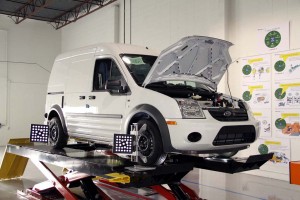Azure Dynamics has landed a record order for hybrid delivery trucks from global shipping company Purolator, the start-up firm will announce later today.
While miniscule compared to the sales numbers of passenger car hybrids, like the Toyota Prius or Ford Escape Hybrid, the 600-unit order underscores the shift from conventional to alternative power beginning to sweep through the commercial vehicle market.
A senior official with Canadian-based Azure Dynamics estimate that, “on the conservative side,” hybrids could soon account for anywhere from 5% to 10% of the medium-duty truck market, or as much as 30,000 units in a healthy U.S. market. And demand could grow substantially, forecasts CEO Scott Harrison, if fuel prices keep climbing.
The Purolator order, which will be delivered over the next three years, represents “a significant turning point” for Azure Dynamics, one of the two major players in the commercial hybrid truck market. The firm has been steadily narrowing the losses Harrison says are to be expected of a player in such an emerging market, one where start-up costs are substantial.
“We could come pretty close to cash flow breakeven this year,” Harrison said during an interview with TheDetroitBureau.com.
Azure Dynamics, which operates its U.S. headquarters in the Detroit suburb of Oak Park, has been in the news a fair bit in recent weeks. The maker has partnered with Ford Motor Co. on the development of a light-duty battery-electric van based on Ford’s Transit Connect model. The first production versions were shipped to customers just before the end of the year, and production is expected to ramp up throughout 2011.
On a volume basis, the Transit Connect is projected to generate significant numbers for Azure, though bigger vehicles, such as those being shipped to Purolator, will yield far more revenues considering the price tag for converting conventional gasoline-powered medium-duty trucks to hybrid power, about $30,000 apiece.
That figure is actually down by roughly a third, following a shift to a next-generation hybrid powertrain Azure Dynamics launched late in 2010. Among other key steps, the driveline now uses smaller, lighter and more powerful lithium-ion batteries rather than prior-generation nickel-metal hydride batteries.
According to Harrison, the hybrid system is expected to yield an annual savings of about $7,000 in fuel and maintenance costs, which translates into a payback period of about 4.5 years.
Azure is looking for ways to further reduce the cost of its technology, each additional 10% reduction in the cost of its hybrid driveline trimming the payback period by about 6 months. Each 50 cent increase in gasoline reduces the payback period about the same amount. With some experts predicting gas prices will rise to $5 a gallon, that could be a significant shift in favor of hybrid propulsion.
As TheDetroitBureau.com has reported, fleet operators could wind up a major force in the so-called “electrification” of the transportation industry. (Click Here for more.)
“The cost is still too expensive for consumers,” contends Stefan Jacoby, CEO of Volvo Cars. Instead, he believes, the real boom market “will be primarily among fleets for a considerable time.”
That’s true, analysts suggest, for both battery-electric vehicles, like Transit Connect Electric, as well as hybrids, such as those ordered by Purolator – and for both passenger cars and for trucks. General Electric recently announced plans to switch half its vast fleet to battery power, with the industrial giant placing an initial order for 14,000 Chevrolet Volts.
Fleet operators have a number of reasons why battery power makes sense. They generally have a clear picture of how much each of their vehicles will be driven on any particular day, and they’re much more cognizant of per-mile operating costs than retail customers.
They’ve also got central depots to bring vehicles back to for charging should they switch to plug-in or pure battery power.
Harrison noted that Azure Dynamics is developing a plug-in version of its hybrid drivetrain that it hopes to launch late this year. It would probably begin by offering the technology on its 14 to 16-passenger shuttle buses. Used at places like airports, they run relatively limited routes that could be serviced on the relatively modest range of a plug-in, sharply reducing energy costs in the process, said the company’s CEO.

